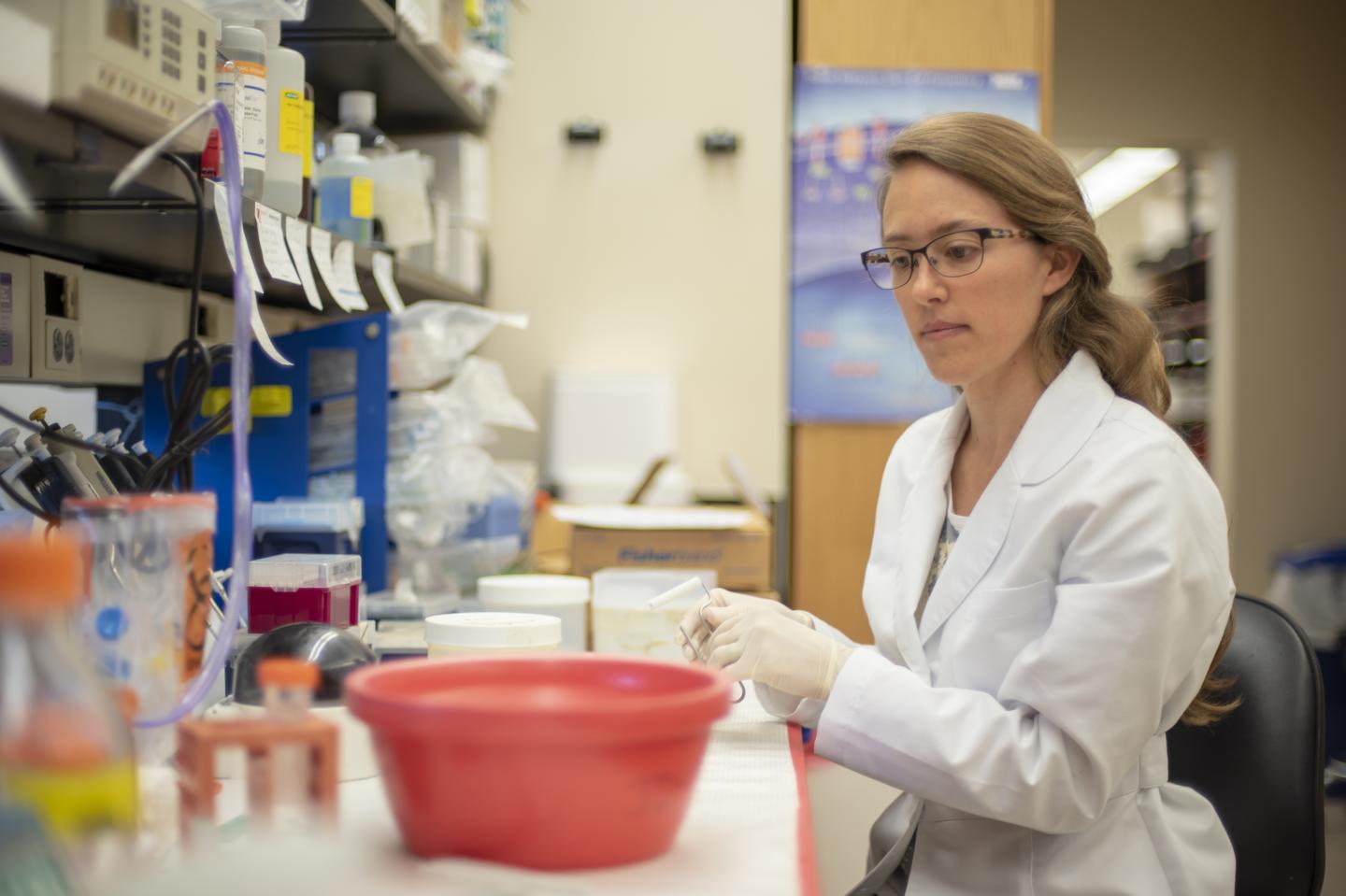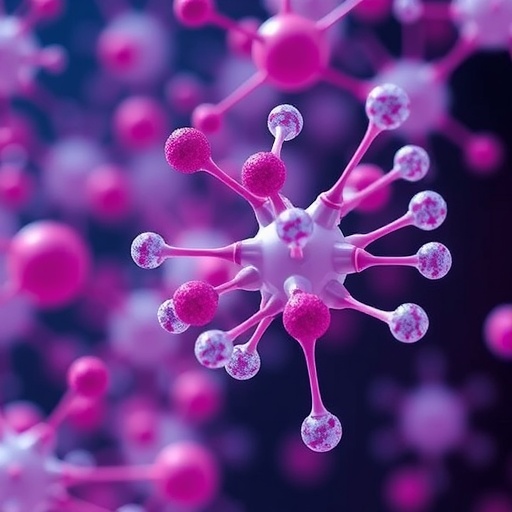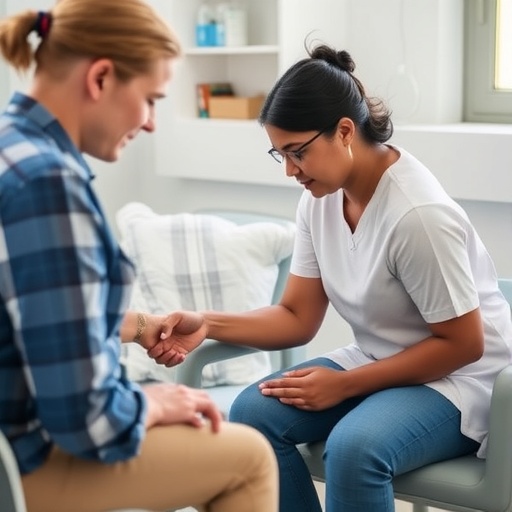Hollings Cancer Center researchers at the Medical University of South Carolina probed deeper into how cell division cycles are regulated

Credit: MUSC Hollings Cancer Center
Combining tissue imaging and artificial intelligence, Hollings Cancer Center researchers at the Medical University of South Carolina probed deeper into how cell division cycles are regulated, in this study released online in the May 2019 issue of Cell Reports.
Addressing a long unanswered question of how cell division is controlled during development and normal maintenance in multicellular organisms, Maria Cuitino, Ph.D., and colleagues used animal models and applied deep learning tools to measure protein levels and expose cellular mechanisms that previously could only be estimated by cell culture systems. The findings begin to identify the possible early events associated with uncontrolled cell division, a key step in the early progression to cancer.
Past research revealed which molecules direct cells to divide or not divide, but this left many scientific gaps. Since bodies are made up of many different types of cells that come together to form complex organs, studying the whole body at once can be very complicated, but also can be very exciting and revealing, says Gustavo Leone, Ph.D., Hollings Cancer Center director and corresponding author on the study.
Previous studies that looked at individual cells in in vitro cell culture systems provided basic answers to the biology going on inside the cell but missed the interactions that occur when all of the cells are working together to form organs. Leone and his team’s findings confirmed at least 80% of the previous knowledge derived from cell culture systems and addressed new important questions that needed to be answered.
“Not knowing when and where “on and off” switches for cell division are expressed is like having paint with no canvas. Now we have the canvas, and thus the cellular context, for how these proteins behave within cells in the body,” Leone says.
The five-year project probed “when” and “where” a critical family of transcription factor proteins (E2F family) is expressed in mammalian cells. Mammals have at least nine different E2F transcription factors that have either activation (on) or repressive (off) functions. All units within cells must work properly to make a functioning organ. “Our DNA provides the code to make the multiple proteins, which are the functional units of our cells. Transcription is the first biological process that makes proteins from DNA, and transcription factors are the on and off switches for this process,” Leone explains.
Cancer is one of the most common diseases that occurs when cells multiply in an uncontrolled manner. Understanding the on and off switches, the transcriptions factors, is essential to understand disease processes like cancer.
Instead of studying cell division regulation in cultured cells (or in vitro), the researchers used a whole-organism approach. Two major discoveries were made in this study. The most surprising discovery during this work was that the same E2F family of proteins are organized into two modules that work similarly in all cell types and organs in our bodies. “So it appears that a universal mechanism has evolved to control cell divisions, regardless of the diversity of cell types existing in our bodies,” he says.
The second discovery was the development of tools that allow this level of precision in the analysis of proteins in complex tissues. Critical to the artificial tools developed in this study was Hollings Cancer Center researcher Thierry Pecot, Ph.D. “To be able to develop the tools that can detect the infrequent presence of transcription factors in every cell and quantify them is both clinically and biologically relevant,” Pecot says.
The Leone lab harnessed the power of artificial intelligence to quantify transcription factors across numerous cells in mouse tissues. While deep learning-based tools have been used for medical imaging before, it was not advanced enough to recognize individual cells in microscopic images within tissues/organs. The technology used by the lab is similar to how self-driving cars recognize objects on the street and allowed the identification of individual cells.
Often the exact clinical relevance of a particular biological discovery is not clear for decades. Currently other papers and emerging data from this group show hints of the role of E2F in cancer. The Leone laboratory uncovered that three transcription factors (E2F3A, E2F8, E2F4) work together to control cell division, while two others combine to stop cell division. These findings provide the strong foundation for further studies to understand these complex mechanisms.
This National Institutes of Health-funded research was driven by an international team of researchers with broad training and expertise, with the lead authors originating from Argentina, France, and China, which allowed for a great breadth of thought processes and determination, Leone says. “Solid elegant research leads to more questions, and that is certainly true in this comprehensive in-depth study of mammal E2F transcription factors.”
The study prompts important questions for future research, says Leone. Using advanced technology, “we uncovered when and where the on and off switch modules for cell division are expressed in intact organisms”. However, we do not know why there are multiple on and off switches, and whether these switches have redundant roles.”
###
Disclaimer: The content is solely the responsibility of the authors and does not necessarily represent the official views of the National Institutes of Health.
About Hollings Cancer Center
The Hollings Cancer Center at the Medical University of South Carolina is a National Cancer Institute-designated cancer center and the largest academic-based cancer research program in South Carolina. The cancer center is comprised of more than 120 faculty cancer scientists with a research funding portfolio of $44 million and a dedication to reducing the cancer burden in South Carolina. Hollings offers state-of-the-art diagnostic capabilities, therapies and surgical techniques within multidisciplinary clinics that include surgeons, medical oncologists, radiation therapists, radiologists, pathologists, psychologists and other specialists equipped for the full range of cancer care, including more than 200 clinical trials. For more information, please visit http://www.
About MUSC
Founded in 1824 in Charleston, MUSC is the oldest medical school in the South, as well as the state’s only integrated, academic health sciences center with a unique charge to serve the state through education, research and patient care. Each year, MUSC educates and trains more than 3,000 students and 700 residents in six colleges: Dental Medicine, Graduate Studies, Health Professions, Medicine, Nursing and Pharmacy. The state’s leader in obtaining biomedical research funds, in fiscal year 2018, MUSC set a new high, bringing in more than $276.5 million. For information on academic programs, visit http://musc.
As the clinical health system of the Medical University of South Carolina, MUSC Health is dedicated to delivering the highest quality patient care available, while training generations of competent, compassionate health care providers to serve the people of South Carolina and beyond. Comprising some 1,600 beds, more than 100 outreach sites, the MUSC College of Medicine, the physicians’ practice plan, and nearly 275 telehealth locations, MUSC Health owns and operates eight hospitals situated in Charleston, Chester, Florence, Lancaster and Marion counties. In 2018, for the fourth consecutive year, U.S. News & World Report named MUSC Health the number one hospital in South Carolina. To learn more about clinical patient services, visit http://muschealth.
MUSC and its affiliates have collective annual budgets of $3 billion. The more than 17,000 MUSC team members include world-class faculty, physicians, specialty providers and scientists who deliver groundbreaking education, research, technology and patient care.
Media Contact
Dawn Brazell
[email protected]
Related Journal Article
http://dx.




